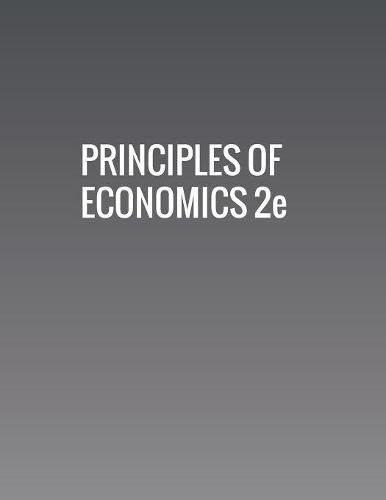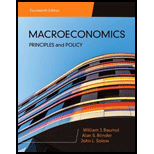
Principles Of Economics 2e
2nd Edition
ISBN: 9781680920864
Author: Timothy Taylor, Steven A. Greenlaw, David Shapiro
Publisher: MCGRAW-HILL HIGHER EDUCATION
expand_more
expand_more
format_list_bulleted
Concept explainers
Textbook Question
Chapter 28, Problem 36CTQ
How does rule-based
Expert Solution & Answer
Trending nowThis is a popular solution!

Students have asked these similar questions
What are two examples of where historical cost is used within the financial statements.
State both the account name and the amount for each account selected.
What was the amount of revenue that Airbnb reported for 2024?
Did the revenue grow over the prior year of 2023?
What was the dollar and the percentage increase or decrease?
What was the amount of revenue that Airbnb reported for 2024?
Did the revenue grow over the prior year of 2023?
What was the dollar and the percentage increase or decrease?
What was the amount of net income or net loss that Airbnb reported for the year of 2024?
Did the net income increase or decrease versus the prior year of 2023?
What was the dollar and the percentage increase or decrease?
Who are the Airbnb's independent auditors and what is the role of these auditors?
What opinion do the Airbnb independent auditors express regarding the financial statements and what does this opinion mean to an investor?
Chapter 28 Solutions
Principles Of Economics 2e
Ch. 28 - Why is it important for the members of the Board...Ch. 28 - Given the danger of bank runs, why do banks not...Ch. 28 - Bank runs are often described as self-fulfilling...Ch. 28 - If the central bank sells 500 in bonds to a bank...Ch. 28 - What would be the effect of increasing the banks...Ch. 28 - Why does contractionary monetary policy cause...Ch. 28 - Why does expansionary monetary policy causes...Ch. 28 - Why might banks want to hold excess reserves in...Ch. 28 - Why might the velocity of money change...Ch. 28 - How is a central bank different from a typical...
Ch. 28 - List the three traditional tools that a central...Ch. 28 - How is bank regulation linked to the conduct of...Ch. 28 - What is a bank run?Ch. 28 - In a program of deposit insurance as it is...Ch. 28 - In government programs of bank supervision, what...Ch. 28 - What is the lender of last resort?Ch. 28 - Name and briefly describe the responsibilities of...Ch. 28 - Explain how to use an open market operation to...Ch. 28 - Explain how to use the reserve requirement to...Ch. 28 - Explain how to use the discount rate to expand the...Ch. 28 - How do the expansionary and contractionary...Ch. 28 - How do tight and loose monetary policy affect...Ch. 28 - How do expansionary, tight, contractionary, and...Ch. 28 - Which kind of monetary policy would you expect in...Ch. 28 - Explain how to use quantitative easing to...Ch. 28 - Which kind of monetary policy would you expect in...Ch. 28 - How might each of the following factors complicate...Ch. 28 - Define the velocity of the moneyCh. 28 - What is the basic quantity equation of money?Ch. 28 - How does a monetary policy of inflation target...Ch. 28 - Why do presidents typically reappoint Chairs of...Ch. 28 - In what ways might monetary policy be superior to...Ch. 28 - The term moral hazard describes increases in risky...Ch. 28 - Explain what would happen if banks were notified...Ch. 28 - A well-known economic model called the Phillips...Ch. 28 - How does rule-based monetary policy differ from...Ch. 28 - Is it preferable for central banks to primarily...Ch. 28 - Suppose the Fed conducts an open market purchase...Ch. 28 - Suppose the Fed conducts an open market sale by...Ch. 28 - All other things being equal, by how much will...Ch. 28 - Suppose now that economists expect the velocity of...Ch. 28 - If GDP is 1,500 and the money supply is 400, what...Ch. 28 - If GDP now rises to 1,600, but the money supply...Ch. 28 - If GDP now falls back to 1,500 and the money...
Additional Business Textbook Solutions
Find more solutions based on key concepts
The way to evaluate a project’s unlevered cost of capital when the project’s risk varies from that of a firm. I...
Corporate Finance (4th Edition) (Pearson Series in Finance) - Standalone book
11-13. Discuss how your team is going to identify the existing competitors in your chosen market. Based on the ...
Business Essentials (12th Edition) (What's New in Intro to Business)
Quick ratio and current ratio (Learning Objective 7) 1520 min. Consider the following data: COMPANY A B C D Cas...
Financial Accounting, Student Value Edition (5th Edition)
(Capital structure theory) Match each of the following definitions to the appropriate terms:
Foundations Of Finance
Tennessee Tool Works (TTW) is considering investment in five independent projects, Any profitable combination o...
Engineering Economy (17th Edition)
To what does the lifetime value of the customer refer, and how is it calculated?
MARKETING:REAL PEOPLE,REAL CHOICES
Knowledge Booster
Learn more about
Need a deep-dive on the concept behind this application? Look no further. Learn more about this topic, economics and related others by exploring similar questions and additional content below.Similar questions
- Does Airbnb's fiscal year-end coincide with a calendar year-end? What products and/or services does Airbnb sell? Please be detailed. What major industry does Airbnb operate in? name at least two competitors. What are two risks identified by Airbnb management? Describe these risks.arrow_forwardSolve please and thanks!arrow_forwardSolve please and thank youarrow_forward
- not use ai pleasearrow_forward(d) Calculate the total change in qı. Total change: 007 (sp) S to vlijnsi (e) B₁ is our original budget constraint and B2 is our new budget constraint after the price of good 1 (p1) increased. Decompose the change in qı (that occurred from the increase in p₁) into the income and substitution effects. It is okay to estimate as needed via visual inspection. Add any necessary information to the graph to support your 03 answer. Substitution Effect: Income Effect:arrow_forwardeverything is in image (8 and 10) there are two images each separate questionsarrow_forward
- everything is in the picture (13) the first blank has the options (an equilibrium or a surplus) the second blank has the options (a surplus or a shortage)arrow_forwardeverything is in the photo (27) the first blank has options (The US, Mexico, Canada) the second blank has the options (The US, Mexico, Canada)arrow_forwardeverything is in photo (26)arrow_forward
arrow_back_ios
SEE MORE QUESTIONS
arrow_forward_ios
Recommended textbooks for you
 Economics (MindTap Course List)EconomicsISBN:9781337617383Author:Roger A. ArnoldPublisher:Cengage Learning
Economics (MindTap Course List)EconomicsISBN:9781337617383Author:Roger A. ArnoldPublisher:Cengage Learning
 Economics Today and Tomorrow, Student EditionEconomicsISBN:9780078747663Author:McGraw-HillPublisher:Glencoe/McGraw-Hill School Pub Co
Economics Today and Tomorrow, Student EditionEconomicsISBN:9780078747663Author:McGraw-HillPublisher:Glencoe/McGraw-Hill School Pub Co
 Exploring EconomicsEconomicsISBN:9781544336329Author:Robert L. SextonPublisher:SAGE Publications, Inc
Exploring EconomicsEconomicsISBN:9781544336329Author:Robert L. SextonPublisher:SAGE Publications, Inc

Economics (MindTap Course List)
Economics
ISBN:9781337617383
Author:Roger A. Arnold
Publisher:Cengage Learning


Economics Today and Tomorrow, Student Edition
Economics
ISBN:9780078747663
Author:McGraw-Hill
Publisher:Glencoe/McGraw-Hill School Pub Co


Exploring Economics
Economics
ISBN:9781544336329
Author:Robert L. Sexton
Publisher:SAGE Publications, Inc
